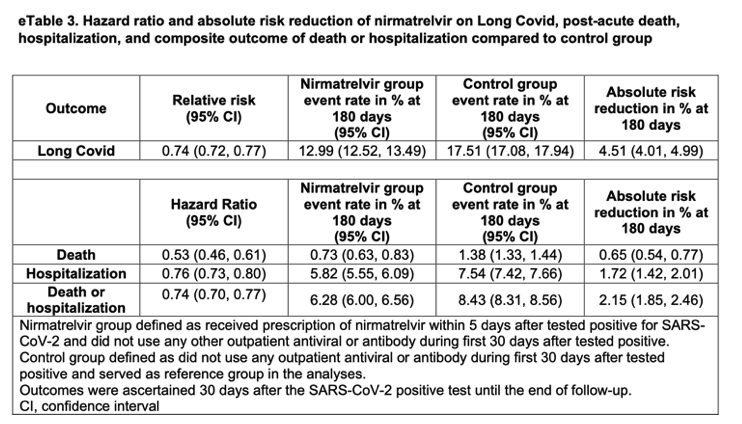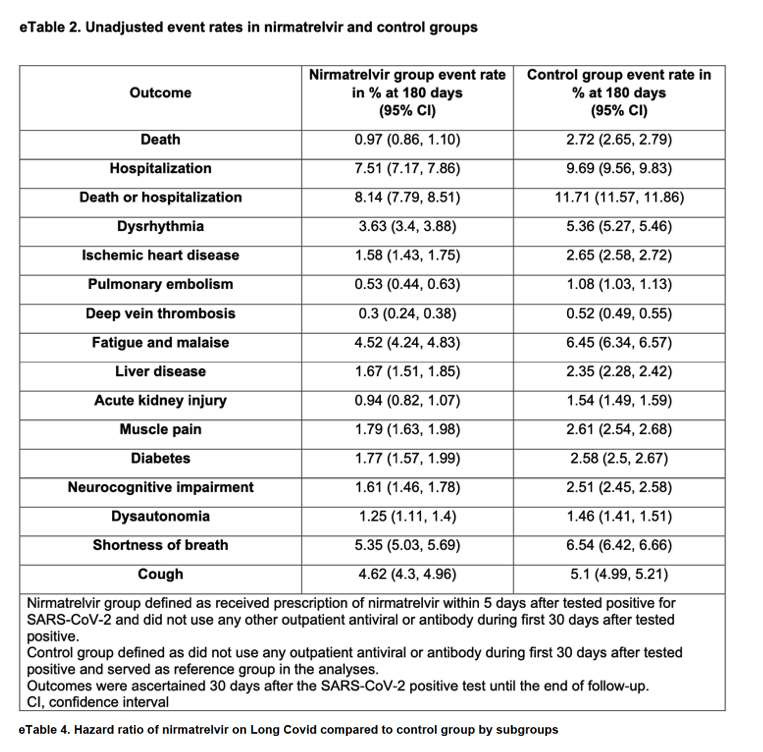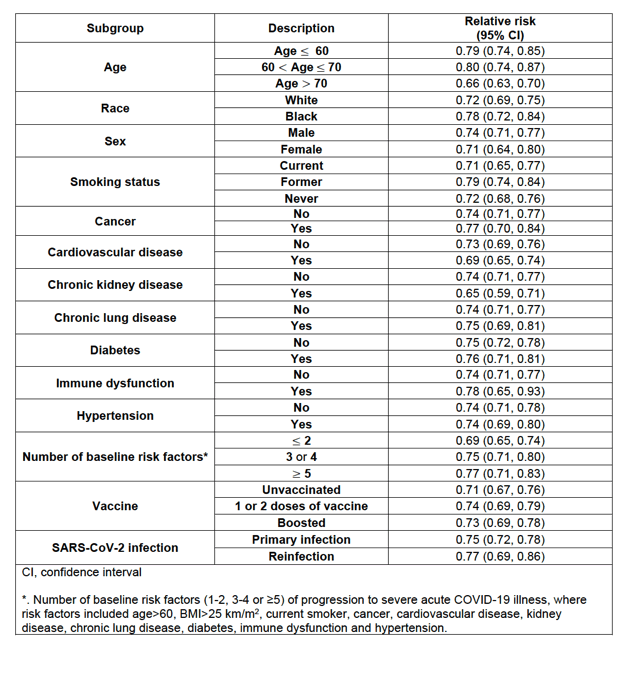| |
Association of Treatment With Nirmatrelvir and the Risk of Post-COVID-19 Condition
|
| |
| |
Download the PDF here
Download the PDF here
Question Is treatment with nirmatrelvir in the acute phase of SARS-CoV-2 infection associated with a lower risk of post-COVID-19 condition (PCC)?>
Findings In this cohort study of 281 793 people with SARS-CoV-2 infection who had at least 1 risk factor for progression to severe COVID-19 illness, compared with 246 076 who had no treatment, nirmatrelvir use in the acute phase (n = 35 717) was associated with reduced risk of PCC, including reduced risk of 10 of 13 post-acute sequelae in various organ systems, as well as reduced risk of post-acute death and post-acute hospitalization. Nirmatrelvir was associated with reduced risk of PCC in people who were unvaccinated, vaccinated, and boosted, and in people with primary SARS-CoV-2 infection and reinfection.>
Meaning In people with SARS-CoV-2 infection and at least 1 risk factor for progression to severe COVID-19 illness, treatment with nirmatrelvir during the acute phase of COVID-19 was associated with reduced risk of PCC.
March 23, 2023
Nirmatrelvir was associated with 26% less risk of PCC, 47% less risk of post-acute death, and 24% less risk of post-acute hospitalization; the magnitude of risk reduction on the absolute scale is also substantial amounting to 4.51, 0.65, and 1.72 less cases of PCC, post-acute death, and post-acute hospitalization for every 100 treated persons between 30 to 180 days of infection. These findings should be contextualized within the broader body of evidence showing effectiveness of nirmatrelvir in also reducing risk of hospitalization or death in the acute phase.6 The clinical decision to initiate treatment with nirmatrelvir should consider its overall effectiveness in reducing burden of death and disease in both the acute and post-acute phases of COVID-19. These findings suggest that the salutary benefit of nirmatrelvir may extend to the post-acute phase of COVID-19.
nirmatrelvir was associated with reduced risk of PCC 26% (RR, 0.74; 95% CI, 0.72-0.77; ARR, 4.51%; 95% CI, 4.01-4.99), including reduced risk of 10 of 13 post-acute sequelae (components of PCC) in the cardiovascular system (dysrhythmia and ischemic heart disease), coagulation and hematologic disorders (pulmonary embolism and deep vein thrombosis), fatigue and malaise, acute kidney disease, muscle pain, neurologic system (neurocognitive impairment and dysautonomia), and shortness of breath. Nirmatrelvir was also associated with reduced risk of post-acute death 47% (HR, 0.53; 95% CI, 0.46-0.61); ARR, 0.65%; 95% CI, 0.54-0.77), and post-acute hospitalization 24% (HR, 0.76; 95% CI, 0.73-0.80; ARR, 1.72%; 95% CI, 1.42-2.01). Nirmatrelvir was associated with reduced risk of PCC in people who were unvaccinated, vaccinated, and boosted, and in people with primary SARS-CoV-2 infection and reinfection.
Risk of PCC
Compared with the control group, nirmatrelvir was associated with reduced risk of PCC (RR, 0.74; 95% CI, 0.72-0.77); the event rate was 12.99% (95% CI, 12.52-13.49) and 17.51% (95% CI, 17.08-17.94) at 180 days in the nirmatrelvir and the control groups, respectively. This corresponded to an ARR of 4.51% (95% CI, 4.01-4.99) at 180 days (Figures 1A and 2A; eTable 3 in Supplement 1).
Risk of PCC in Subgroups
Compared with the control group, people treated with nirmatrelvir exhibited reduced risk of PCC in subgroups based on age, race, sex, smoking, cancer, cardiovascular disease, chronic kidney disease, chronic lung disease, diabetes, immune dysfunction and hypertension (Figure 3A; eTable 4 in Supplement 1).br clear="all" />
Because nirmatrelvir is prescribed to people with at least 1 baseline risk factor for progression to severe acute COVID-19 illness, and to better understand the association between nirmatrelvir and the risk of PCC in people with different baseline risk strata, the association between nirmatrelvir and the risk of PCC was tested according to the number of baseline risk factors for progression to severe acute COVID-19 illness. Nirmatrelvir was associated with reduced risk of PCC in people with 1 to 2, 3 to 4, and 5 or more baseline risk factors (Figure 3B; eTable 4 in Supplement 1).



|
|
| |
| |
|
|
|